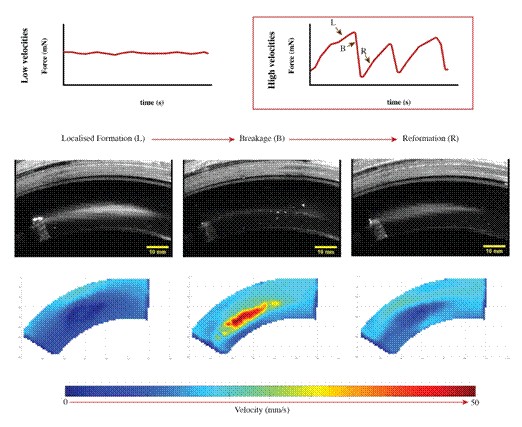Ministry of Science & Technology
Scientists trace chaotic movements through fluids like polymer solution, gel useful for oil & cosmetic industry
Posted On:
21 NOV 2025 5:29PM by PIB Delhi
Researchers have recently developed a novel method to investigate how fluids formed by surfactant or soap molecules (wormlike micellar fluids) behave up close, at the level of a single moving object.
These systems find a wide range of applications in oil field industries and cosmetics and hence study of such fluids with flexible rod-like supramolecular aggregates of surfactants in water could benefit related industries.
Imagine dropping an object in a simple Newtonian fluid such as water or cooking oil. Initially, the object accelerates and finally attains a steady velocity called the “terminal velocity” as the force due to gravity balances with the drag coming from the fluid. Falling raindrops also reach a terminal velocity due to air drag before hitting the surface of Earth. However, an object moving through fluids like as a polymer solution, gel, or shampoo (technically called non-Newtonian fluids) may never attain a terminal velocity and exhibits complex time variations -- typically attributed as “chaotic motion.” This happens because the local structures in the fluid continuously build up and break due to the force generated by the moving ball. Modelling such complex motion using a general theoretical framework is a daunting task and scientists have been trying to find ways to unravel this mystery.
To explore this hidden world, researchers at the Raman Research Institute (RRI), an autonomous institute funded by the Department of Science and Technology (DST), Government of India have built a special device inside a rheometer—a machine that measures how materials flow. Their custom set-up held the fluid between two cylinders while a needle-like probe moved through it.
This setup allowed them to see how the fluid behaved and feel and measure the forces acting on the probe as well as visualize local fluid structures and velocity fields using in-situ optical imaging for further microscopic insights.

Fig 1. The experimental set-up devised to study the forces a probe faces moving through a WMF
The team found that at smaller probe velocities, force remains constant in time, showing response similar to a Newtonian fluid (fluids like water). Beyond a velocity threshold, the force starts to show many repeated cycles of slow build-up followed by a sudden drop, creating rhythmic bursts—a jagged “sawtooth” pattern.
Using high-speed optical imaging to measure the local fluid-structures and the velocity field, the researchers found that the fluid creates a tail-like structure called “wake” during the force build-up, which rapidly detaches from the probe during the force drop event. The force response is essentially similar to a progressive stretching and snapping of an elastic rubber band.

Fig 2. At higher velocities, the force exhibits a sawtooth pattern.
“The design of the custom-built set-up provides the flexibility and freedom to explore many aspects in the context of probe motion to access, measure and reveal the behaviour of complex materials,” said Abhishek Ghadai, PhD Scholar at RRI and the lead author of the paper.
The unique observation revealed in this research published in the journal J. Rheol. cannot be explained by the conventional bulk mechanical measurement of the non-Newtonian fluids. This further highlights the importance of local structure and dynamics in controlling the motion of small probes through these materials.
“Our study highlights the importance of investigating the mechanics of materials over different length scales to understand complex materials for applications and fundamental scientific interests,” said Prof. Sayantan Majumdar, faculty member at RRI, who led the project.
The researchers believe that studying different classes of systems in the context of the motion of the probes of varying sizes will create an interesting avenue to reveal and understand many interesting aspects in science and technology.
Publication link: https://doi.org/10.1122/8.0000939
****
NKR/AK
(Release ID: 2192569)
Visitor Counter : 151